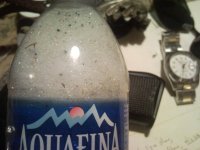Matanuskan Flo
Member


 hello all,
hello all,I have been trying to get some info on here regarding the uses of fine grain, food quality, pure silica mineral. it is like a very fine white sand. will this help kill gnats & deter pests thru top dressing?? is it beneficial to mix into my medium?? does it have nutrient value?? if so, what kind of value does it endow?? any info would help!! my friend recommends to mix & top dress, but just said he heard it was good for the ladies & had no clue why. he uses it with great success, but has not every had a gnat/aphid infestation to date, so he cannot help me on that point. i am wondering if it will mimic DE(diatomaceous earth) & strip the exo-skeletons of the damned pests. any info would be great. thanx all. theres a pic below of one of the bottles i have of the silica, i have about 3 bottles or 40oz. the other pic is just perfection & the only other lady allowed in my house & heart.......






